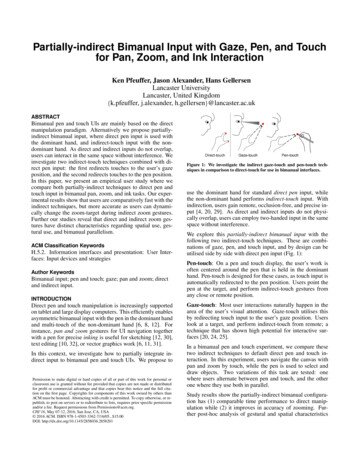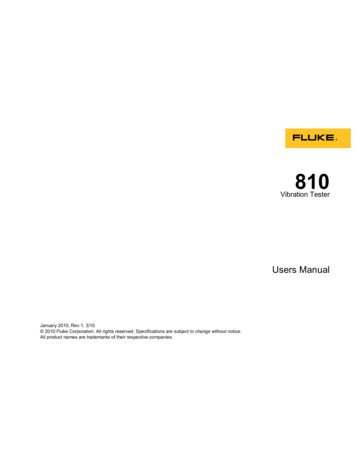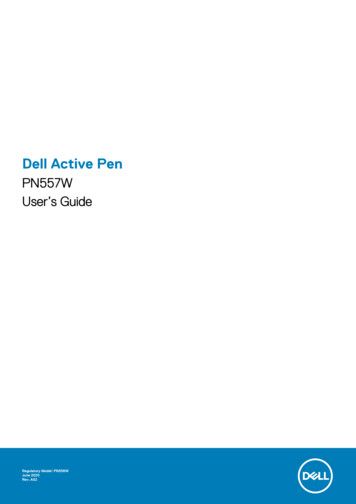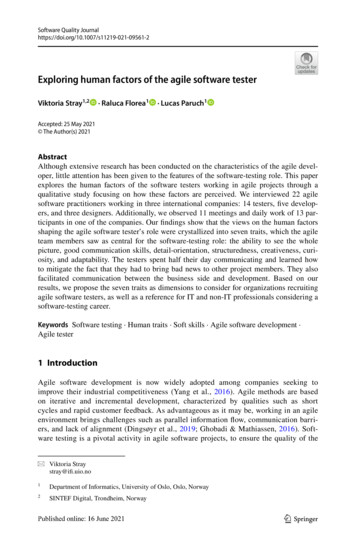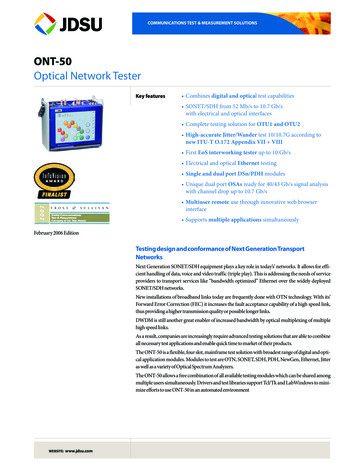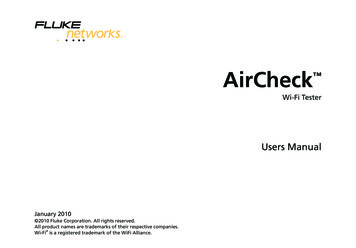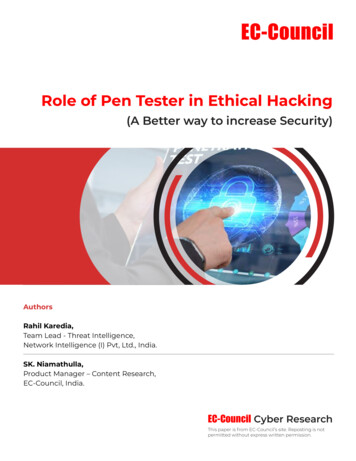
Transcription
Role of Pen Tester in Ethical Hacking(A Better way to increase Security)AuthorsRahil Karedia,Team Lead - Threat Intelligence,Network Intelligence (I) Pvt, Ltd., India.SK. Niamathulla,Product Manager – Content Research,EC-Council, India.EC-Council Cyber ResearchThis paper is from EC-Council’s site. Reposting is notCopyright by EC-Councilpermitted without express written permission.01All Rights Reserved by the Author. Reproduction is Strictly Prohibited.
Table of ContentPenetration Testing and Ethical HackingIntroduction to Penetration TestingWhy Perform a Penetration TestingWhen to Perform Penetration Testing?Methodologies of Penetrating TestingPenetration Testing ProcessTest PreparationWhat are FIVE Phases in Penetration Testing1. Information Gathering2. Scanning:3. Discover Vulnerability:4. Exploitation:5. Report Generation:Penetration AnalysisTop 7 Steps to Conduct Penetration TestingTop 8 Penetration Testing ToolsWhy you need a Penetration Testing from a Business PerspectiveWhy you need a Penetration Testing from an Operational PerspectiveTools for Penetration TestingRole of a Pen TesterArea of Penetration TestingInfrastructure Penetration Testing? And Its Types?Copyright by EC-CouncilAll Rights Reserved by the Author. Reproduction is Strictly 3131402
Qualification & Certification of Pen TestersTop 5 Variety of Tailored Pen Testing ServicesProfessional Standards and Technical CompetencyTop 12 Benefit of Penetration TestingETHICAL HACKINGWhat do Ethical Hackers do?Laws Against HackingCategories of HackersBlack Hat hackersWhite hat hackerGrey hat hackersPhases of Ethical HackingReconnaissanceScanningGaining AccessMaintaining AccessClearing tracksRules for ethical hackingSome ethical hacking toolsRequired skills of an ethical hackerPros & Cons of Ethical HackingPenetration vs Ethical HackingCopyright by EC-CouncilAll Rights Reserved by the Author. Reproduction is Strictly 2222303
Introduction to Penetration TestingPenetration testing is more of an art than a science. It is the process of trying to gain unauthorized accessto authorized resources. To put simply, Penetration testing is “breaking into your system” to see how hardit is to do.It is the main branch of network security evaluation; the main aim of penetration testing is to provideanalysis to discover the vulnerabilities and security threats in a network.The purpose of penetration testing is to understand the technique of gaining access to a system by usingstandard PT tools and techniques developed by hackers. After vulnerability assessments, which are beingused to identify and inventory various exposures within the organization’s systems. Penetration testingattempts to exploit anyone of the vulnerabilities to gain unauthorized access.Copyright by EC-CouncilAll Rights Reserved by the Author. Reproduction is Strictly Prohibited.04
Why Perform a Penetration Testing If the vulnerability is utilized by an unauthorized individual to access company resources, the primaryobjective of a penetration test is to focus on vulnerabilities before they can be utilized. Penetrating testing is a valuable assurance. The assessment tool that benefits both business and itsoperations. The main goal of a vulnerability assessment is to identify controlled security vulnerabilities Conditionsthat can be terminated before unauthorized users exploited them. Computing Systems use penetration testing to solve problems of the high severity vulnerabilities.When to Perform Penetration Testing?Penetration Testing plays a vital role in every organization; it is an essential feature that needs to beperformed regularly for protecting the functioning of a network. In addition to this, it should be performedpenetration testing whenever:1. You update your system or install the software2. You add a new network infrastructure3. You relocate your officeMethodologies of Penetrating TestingPenetration Testing Methodology includes 3 types:A Zero-KnowledgeTest (Black Box)The Penetration Test team has no information about the testtarget environment.A Full KnowledgeTest (White Box)The Client organization provides the necessary information tothe test team.A PartialKnowledge Test(Grey Box)The Penetration test team has partial disclosure of informationabout the target environment.Copyright by EC-CouncilAll Rights Reserved by the Author. Reproduction is Strictly Prohibited.05
Gray BoxPenetration TestingBlack BoxPenetration TestingWhite BoxPenetration TestingPenetration TestingFig-1: Methodologies of Penetration testingPenetration Testing ProcessTo conduct a penetration test and document its outcome, a systematic approach which is circulated todifferent organization units and management levels in the organization is required. Penetration testing isconducted in three phases:1. Test Preparation2. Test Testing3. Test AnalysisTest PreparationIn this preparation process, the documents are collected and finalized. In this phase, the scope of the systemcomponents, objective of the test, test duration, and time are identified, agreed, and documented. Due topredicted incidents like information leakage, downtime is defined and recorded in the legal documents, thenthey are agreed upon and signed by both sides.FIVE Phases in Penetration TestingPenetration Testing is a proof-of-concept approach to explore and exploit vulnerabilities. The process ofPen tester confirms whether the vulnerability really exists and further proves that exploiting it can resultin damage to the network. The results of a Penetration testing is, typically, evidence in the form of a log,which confirms the fining and can be a useful aid towards remediation. These are the steps involved in thePT process:1. Information Gathering2. Scanning3. Discover Vulnerability4. Exploitation5. Report GenerationCopyright by EC-CouncilAll Rights Reserved by the Author. Reproduction is Strictly Prohibited.06
Penetration Testing StagesInformation GatheringDiscovery VulnerabilityReport GenerationTools: WAFWOOFTools: Nikto, NessusTools: DocumentScanningExploitationTools: NMAPTools: METASPLOITFig -2: Phases of Penetration Testing1. Information Gathering2. Scanning:In this Information gathering phase, Pen-testergathers all information related to server like:Pen-tester identifiesa. What is the correct domain of web serverandb. How many sub-domains are connected tothis domaina. What type of services is running on theweb-server.b. What are the functions of that particularservice?c. On which port this service is running.c. Is any firewall is set up for web server ornot?d. All assistance is running on whichoperating system.In this phase, we found that the web server’s IP– 123.456.78.911. For detection of the firewall,we will use the tool WAFWOOF (web applicationfirewall detection tool)To do this NMAP (Network Mapper) tool andMetasploit’s Auxiliary facility is used.Copyright by EC-CouncilAll Rights Reserved by the Author. Reproduction is Strictly Prohibited.07
3. Discover Vulnerability:To find the vulnerability in the webserver or any network pen-tester, Nikto, Nessus is mainly used.In this step, the penetration tester will receive the challenge of evaluating and finding the necessary securitydefeats from the target. This task focusses on the process of the pen-testing. It is essential to ensure thateach task, functions, and processes is done accurately. This phase expands into two main procedures:a. Code Analysisb. Vulnerability AnalysisCode AnalysisIt is used to find security flaws by analyzing source code. It is usually analyzed like this would automaticallyfind security flaws with a high degree.Vulnerability AnalysisThis vulnerability analysis is classified into two areas identifying and reducing the number of vulnerabilitiesbefore the software is installed. With identifying vulnerability, it strives to help security engineers understandhow vulnerabilities are created and found.The main goal is that, with this education, security engineers will learn how to detect and eliminate thevulnerabilities in software products before the products are shipped into the system. The reality is thatmany software products are being dispatched with new vulnerabilities that attackers may be able to exploit.This vulnerability remediation process involves a comprehensive approach to securing the network usingthe below equation:Total Vulnerability CA VAWhere CA Code AnalysisVA Vulnerabilities Analysis4. Exploitation:After finding the vulnerability, a pen-tester primary goal is breaching all types of security and take theremote access of the server. For doing this, the pen-tester uses the METASPLOIT tool.5. Report Generation:In this report generation phase, Pen-tester will generate a full report on the testing process.Penetration AnalysisOnce the penetration testing process has been compiled, the next process is to prepare a report. The reportis provided to advisory and various senior management through the reporting process. IT networking staff,IT management will all likely see the final report or at least part of it.Copyright by EC-CouncilAll Rights Reserved by the Author. Reproduction is Strictly Prohibited.08
The report section consists of a core summary, technical details, an overview of risk level indication,assessment finding, budget information, and time estimation, etc.By using this final report, Pen-tester can represent the entire process to the IT department so that the finalresult can be obtained and implemented. A mitigation plan is prepared after the penetration testing.The advisory team plays a vital role in the final phase of the penetration model includes security solutionsand patched information against all found risks such as preparation of countermeasures, Budget Estimation,Time Estimation, Creation Advisory Map, Recheck the implemented solution, etc. In this task, penetrationtester must provide a definitive and conclusive advisory report for various solutions and the cost. In manyinstances, when penetration testing is completed, the client needs to install the suitable patches. In suchcases, the security solution should be provided in both open source and paid solutions. The advisory phase isdepended on the reporting phase because advisory must be prepared after a complete review of all differentreports.Top 7 Steps to Conduct Penetration TestingPenetration Testing provides clear and concise direction on how to secure your organization’s informationand network from real-world attacks. One of the critical factors in the process of penetration testing is itsunderlying methodology.Generally, Penetration testing has Three Phases1. Test Preparation2. Test ExaminationCopyright by EC-CouncilAll Rights Reserved by the Author. Reproduction is Strictly Prohibited.3. Test Analysis09
Test Preparation010504PenetrationTesting Stages0203Test AnalysisFig – 3: Phases of Penetration TestingStep - 1:All the necessary documents for the test are organized and finalized during the test preparationphase.Step - 2:The Pen-testers and the organization meet to decide the scope, objectives, timing, andduration of the test.Step - 3:The information leakages and downtime are resolved and put into the legal agreementdocument.Step - 4:Information gathering from the physical and logical areas of the test target.Step - 5:Identify all pertinent information needed in the vulnerability analysis phaseStep - 6:Depending upon the information gathered, the pen-tester then analyses the vulnerabilitieswithin the targets system, application, etc.Step - 7:The pen-tester may opt to use the manual method or automated method by using tools (Toolsshown in the below table - 1)Copyright by EC-CouncilAll Rights Reserved by the Author. Reproduction is Strictly Prohibited.10
Penetration Testing ToolsName of theToolsSpecific PurposePortabilityNmapNetwork Scanning,Port ScanningOS DetectionLinux, Windows, FreeBSD, OpenBSD,Solaris, IRIX, MacHpingPort Scanning, Remote OSfingerprintingOpenBSD, Solaris, Mac OS X Linux,Free BS, NetBSDSuperScanDetect open TCP/UDP portsRun queries like whois, ping, andhostname lookupsWindows 2000, XP, Vista, Windows 7XprobeRemote active OS fingerprintingLinux and all updated OSpOFOS FingerprintingFirewall detectionLinux, NetBSD OpenBSD, FreeBSD,Mac OS X, SolarisHttprintWeb server fingerprintingDetect web-enabled devicesLinux, Mac OS X, Free BSD, Win32NessusDetect vulnerabilities that allow aremote cracker to access or controlsensitive dataDetect misconfigurationMac OS X, Linux, FreeBSD, OracleSolaris, Windows, AppleScannerDetect network vulnerabilitiesWindows but can scan servers built onany platformCopyright by EC-CouncilAll Rights Reserved by the Author. Reproduction is Strictly Prohibited.11
Why you need a PenetrationTesting from a BusinessPerspectiveWhy you need a PenetrationTesting from an OperationalPerspectiveFrom a professional perspective -From the operational point of view – To protect against failure through preventionof financial loss To prove appropriate diligence and compliancefor industry regulators, customers, andshareholdersQuickly and accurately identify the real andpotential weaknesses Active elimination or mitigation of identityRisk Implementation of corrective measures An increase in IT knowledge Effectively and efficiently – by providing variousinformation and priority vulnerabilities. Well-organized and tested configurationchanges to end the identified risks Determine the effectiveness and probability ofan organization vulnerabilities To protect the corporate image Rationalization of information security To identify and find out risks before safetyviolations Increase awareness about the importance ofsecurity at all levels of the organization Investment Cost- The organization spendsmillions of dollars to recover from cyberattackcosts, corrective efforts, and reduction inrevenue.Tools for Penetration TestingThere are a wide variety of tools that are used in Penetration Testing and the important tools are:NMap:Nmap (a.k.a Network Mapper) is used to develop network services and maps. Nmap sends specificallycrafted packets to the target host and then analyses the responses. Nmap supports the scanning of thevarious types of protocols and most of the existing systems.BeEF:BeEF ( a.k.a Browser Exploitation Framework) focuses on the web browser. It works on Linux, Apple MacOS X, and Microsoft Windows. BeEF allows the professional pen tester to assess the actual security postureof a target environment. It investigates the exploitability in the context of web browsers.Copyright by EC-CouncilAll Rights Reserved by the Author. Reproduction is Strictly Prohibited.12
Metasploit:Area of Penetration TestingMetasploit is a tool that tests for weaknessesin operating systems and applications. Thispenetration testing tool is based on the conceptof ‘exploit’. It runs a set of codes on the test targetcreating a framework for penetration testing. Itworks on Linux, Apple Mac OS X, and MicrosoftWindows.Penetration Testing is generally done in thefollowing three areas:NessusIn-Network Penetration Testing, the network’sphysical structure needs to be tested to identifythe vulnerability and risk. In the networkinginfrastructure, a Pentester discovers securityflaws in the design, implementation, operationpart of the respective organization’s network.Nessus is a penetration testing tool and remotesecurity scanner, typically run on one machineto scan the services offered by a remote machine.Nessus is the world’s most popular vulnerabilityscanner that is used in over 75,000 organizationsworldwide. Nessus tool allows the user to scriptand run specific vulnerability checks. These checksprovide a lot of control where most products donot.Cain and Abel:Cain and Abel mostly used for password cracking.It uses network sniffing, Dictionary attack, Bruteforce, and cryptanalysis attacks, and routingprotocol analysis methods to accomplish this. Thisis entirely for Microsoft operating systems.Role of a Pen TesterThe role of a Pen Tester are:1. Testing across internal security networks.1. Network Penetration Testing2. Application Penetration Testing3. The response of the systemIn the application Penetration Testing, the logicalstructure of the system needs to be tested toidentify vulnerability and risk in an application. Thefirewall and other monitoring systems are utilizedto protect the security system, but sometimes, itneeds to be focused on testing, especially whentraffic can pass through the firewall.The response of the system, in this area, SocialEngineering gathers information on humaninteraction to obtain information about anorganization its system. It is valuable to test theability of the respective organization to preventunauthorized access to its information systems.Likewise, this penetration test is exclusivelydesigned for the workflow of the organization.2. Identifying exposures to protect the mostcritical data.3. Discovering vulnerabilities andthroughout the IT infrastructure.risks4. Prioritizing remediation recommendationsto ensure that the certified security team isutilizing their time most effectively whileprotecting the most significant securitygaps.5. Reporting.Copyright by EC-CouncilAll Rights Reserved by the Author. Reproduction is Strictly Prohibited.13
Infrastructure Penetration Testing? And Its Types?Infrastructure Penetration Testing includes, (a) All Internal systems (B) External devices (C) Internetnetworking (D) Cloud & Virtualization testing.Hidden on your internal network from public view, there is always a possibility that a criminal can leverage,which can damage your Network infrastructure. Therefore, it is better to be safe than sorry.ExternalInfrastructurePenetration TestingInternalInfrastructurePenetration TestingCloud andVirtualizationPenetration TestingWireless Securitypenetration TestingTypes of Infrastructure Penetration TestingFig – 4: Types of Infrastructure Penetration TestingCopyright by EC-CouncilAll Rights Reserved by the Author. Reproduction is Strictly Prohibited.14
Types of Infrastructure Penetration TestingPenetration fy and exploit vulnerabilities onnetworks, applications, exposed to theinternet. The external test is performed overthe internet bypassing the firewallUnderstand the riskof assets exposed tothe internet.InternalPenetrationTestsInsider attacker that has gained access toan end-user system, including escalatingprivileges installing custom-crafted malware.The internal test is performed by connectingto the internal LANUnderstand risk toorganization from abreachCloud &VirtualizationPenetrationTestsIdentifying the attacker in a cloud environmentis challenging. Further, identifying the attackerin a cloud environment is difficult. A criminalattacker can also buy hosting a cloud facility toget access to a user’s new cloud data. Most ofthe cloud hosting is implemented on virtualinfrastructure, causing virtualizing risk thatan attacker can easily access.Discovers real riskswithin the virtualenvironmentandsuggests the methodsand costs fix thethreats and flaws.WirelessSecurityPenetrationTestWireless technology of your handhold devicesprovides easy and flexible access to variousnetworks. The easily accessible technologiesare vulnerable to unique risks. A criminalhacker can hack from the remote location.WSPT is necessary for every organization.To find the potentialrisk and to protectfrom the externalthreats.Copyright by EC-CouncilAll Rights Reserved by the Author. Reproduction is Strictly Prohibited.15
Qualification & Certification of Pen TestersQualification of Pen Testers:Penetration testing can be performed only by a qualified and certified penetration tester. Therefore,certification of a penetration tester is essential.A certified internal and external pen-testers are organizationally independent to perform the penetrationtesting; It means that the Pen-tester must be organizationally independent of the management of the targetsystems. Here are some certifications that will help you while calling a pen tester.CertificationQualified and certified pen tester can perform penetration testing. Certification like C EH held by the testeris an indication of his practical skill sets and penetration testing.Here are the few vital penetration testing certifications: Certified Ethical Hacker (C EH) Certified Ethical Hacker (Practical & Master)Top 5 Variety of Tailored Pen testing ServicesTypes of Penetration TestingPenetration fy and exploit vulnerabilities onnetworks, applications, exposed to theinternet. The external test is performed overthe internet bypassing the firewall.Understand the riskof assets exposed tothe internet.InternalPenetrationTestsInsider attacker that has gained access toan end-user system, including escalatingprivileges installing custom-crafted malware.The internal test is performed by connectingto the internal LAN.Understand risk toorganization from abreachSystematically assess the security of handholddevices and installed applications.Understand the riskintroduced to anorganization throughnewlydevelopedmobile applicationsMobile DeviceAssessmentsCopyright by EC-CouncilAll Rights Reserved by the Author. Reproduction is Strictly Prohibited.16
WebApplicationAssessmentsSystematically assess web applications forweaknesses that can lead to unauthorizedaccess or data exposure.To find the potentialrisk and to protectfrom the externalthreats.Phishing& SocialEngineeringattacksAssess the security awareness and trainingon security controls concerning humanmanipulation and spam email identification.Understandanorganization reactsto the exploitation ofemployeesProfessional Standards and Technical CompetencyProfessional bodies set industrial standards to distinguish members and non-members. It is called a codeof conduct and mark as a guide to the penetration tester. The standard codes of conducts are: EC-CouncilAll testers and personals involved in the PEN test have to keep up their knowledge and update on thetests and development. It is essential to continually develop skills and understanding of the new systemthat is being developed and used. OSSTMM (Open Source Security Testing Methodology Manual) is usedin developing technical skills and knowledge. OWASP Open Web Application Security Project is used forinternet-based applications.Copyright by EC-CouncilAll Rights Reserved by the Author. Reproduction is Strictly Prohibited.17
Top 12 Benefit of Penetration Testing01. A Penetration test is used to identify the risks that may occur when an attacker gets access to the systemand networks.02. Performing a Pen test will help estimate the mitigation plan to close security gaps before the actualattack happens.03. Conducting a Pen test helps organizations to reduce financial and information loss that would havecaused a loss in customer trust due to security breaches.04. Penetration testing safeguards the organizations against failure through preventing financial loss andprovide compliance to industry regulators, customers, and shareholders.05. Penetration testing helps in developing trust, corporate image, and rationalize IT security investments.06. Penetration Testing is a proactive process, it provides unassailable information that helps the organizationto meet the auditing or compliance aspects of regulations.07. Penetration testing helps adherent the audit regulatory standards like PCI DSS, HIPAA, and GLBA. Thisavoids the huge fines for non-compliance.08. One of the main objectives of PEN testing is to create IT security and its importance at all levels in anorganization through structured training and awareness programs to avoid security incidents that maycause damage in terms of confidentiality, integrity, relationship, and customer trust.09. Penetration testing helps an organization to evaluate the level of security awareness among its employees,the effectiveness of the existing security policy and process, and the efficiency of its products.10. Penetration testing helps in the decision-making to evaluate the organization’s security and hence planfor the security investment and IT strategy.11. Penetration testing also helps in shaping the important aspects of information security strategy byidentifying the vulnerabilities quickly and accurately.12. Penetration helps in business to evaluate the impacts and likelihood of the vulnerabilities.13. Penetration testing consumes lots of time, effort, and knowledge depending on the complexity of thebusiness. Therefore, penetration testing supports the enhancement of the knowledge and competencyof the persons involved in the process.Copyright by EC-CouncilAll Rights Reserved by the Author. Reproduction is Strictly Prohibited.18
ETHICAL HACKINGHacking is detecting imperfection in the systemor network to exploit its weakness to gain accessor simply unauthorized access to anyone’s system.The first known hacking event took place in 1960at MIT, and at the same time, the term “hacker”was originated. Users who attack someone elsesystem for their gain or to fulfil their agendaare known as hackers. Hackers are also called ascrackers, intruders or attackers.Ethical HackingIt is just inverse of criminal hacking. Its goal is toprove a service for a client to test his environmenton which it will cope with the hacker’s attack; theoutput of ethical hack is a detailed report about thedetected problems, vulnerabilities, and reports.It often has instructions on how to vanish thosevulnerabilities. Independent computer securityprofessionals breaking into the computer systemwith legal permission of the system owner areethical hackers. Big organizations like Facebook,Google, and yahoo hire ethical hackers to tellthem the weakness in their network or any smallloophole. If someone wants to attack an ethicalhackers system, it will bounce back and go back tothem. Ethical hacking is also called as penetrationhacking.Ethical hacker – (a) Address vulnerabilities andrisks (b) Explain and suggest the avoidanceprocedures (c) Finally, prepare a final report of allethical activities that he did and observed whileperforming penetration testing.Laws Against HackingComputer Fraud & Abuse Act (CFA)It makes illegal the distribution of computer codei.e., placing computer code on a computer systemor network that can be used to cause damage alleconomic loss.Economic Espionage Act (EEA) Used bothdomestically and internationally to make illegalthe theft of trade secrets.The Wire Fraud Act (WFA) It makes illegalto misuse the wire communications.The Identity Theft & AssumptionDeterrence Act (ITADA)Protect individuals who are victims of fraud whenit comes to hacking.Father of HackingIn 1971 John Draperaka Captain Crunch was thefirst phone hacker and was called the father ofhacking.What do Ethical Hackers do?A Certified Ethical Hacker tries to find the answersto the following questions –1. Vulnerabilities that an attacker can hit2. What can an attacker see on the targetsystem?3. What can an attacker do with thatconfidential information?Copyright by EC-CouncilAll Rights Reserved by the Author. Reproduction is Strictly Prohibited.19
Categories of HackersThere are mainly three types of hackers.Black Hat hackersThese attackers are those who harm anyone for their good to earn money or any other personal benefits.They are criminal hackers.Bad intension without permission black hat hackerWhite hat hackerThey are trained professionals hired by the company to hack into their network and find the bloopers andtry to give solutions to those peoples. They work in a novel way and are known as white hat hackers orethical hackers.Good intension with permission white hat hacker.Grey hat hackersThese hackers have characteristics of both black and white hat hackers. They don’t have a personal conflictwith the party they are attacking but instead they do it for fun, but without permission. Unlike white hat,grey hat hackers often publicize systems vulnerability.No bad intentions without permission grey hat Hacker.Phases of Ethical HackingReconnaissanceIt’s the first and most extended phase of ethical hacking, sometimes lasting weeks or months. In this attacker,gather (collect) the sufficient information from many sources before the attack. This can be performedeither actively or passively. E.g., it’s easy to find the OS version number and the type of web server that acompany’s uses with this the hacker can find a vulnerability in that OS version and exploit it to gain access.The tools used in this phase are NMAP, Hping, Google Dorks, Maltego.ScanningIt is the second phase of ethical hacking. In this, after gathering all the information, the hacker begins theprocess of scanning perimeter and internal network devices looking for weaknesses in them. It examines allthe open as well as close ports. The tools involved during scanning are dialers, sweepers, ports scanner, andnetwork mappers, etc.Gaining AccessIt is the third phase of ethical hacking. Here real hacking takes place. All the information gathers duringreconnaissance and scanning are misused to gain access. E.g., Stack-based buffer overflows, Does, andCopyright by EC-CouncilAll Rights Reserved by the Author. Reproduction is Strictly Prohibited.20
password cracking. The method used by the hackers to establish a connection for intruding in someoneelse system can be LAN, local access to a pc, offline, and internet. The foremost tool used in this phase isMetasploit.Maintaining AccessAfter gaining access, the hacker inserts some backdoors, Trojan, rootkits in the owned system for futureaccess. The owned system also called a zombie system.Clearing tracksIn this phase, to hide his wrong deeds, the attacker drops out all the activity logs perform during hacking.He removes all the pieces of evidence the can be harmfu
Pros & Cons of Ethical Hacking 22 Penetration vs Ethical Hacking23 . Cop EC-Council 04 Introduction to Penetration Testing Penetration testing is more of an art than a science. It is the process of trying to gain unauthorized access to authorized resources. To put simply, Penetration testing is "breaking into your system" to see how hard .

